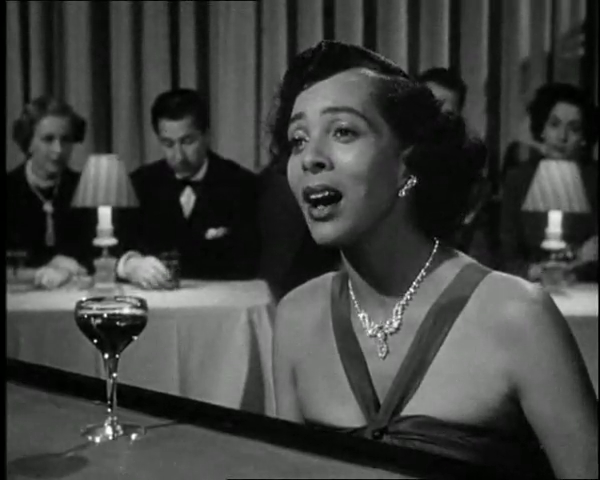
A late-night film buff watching “In a Lonely Place,” starring Humphrey Bogart, may have wondered who was the Black woman pianist/singer? That was Hadda Brooks, and along with being an attractive torch singer she could torch the keyboards with her boogie-woogie beat, so much so that in the 1940s she was considered the queen of the style.
By Herb Boyd, New York Amsterdam News
In the film her appearance in the nightclub scene was a cameo with Brooks singing a warm and enticing version of Ray Noble’s song “I Hadn’t Anyone Till You.” This was quite a departure from her popular brand of recordings, including her rhythm and blues romps for Modern Records. But when she wasn’t rockin the joint or the recording studio, she could put a romantic tinge to a ballad, as she did on “That’s My Desire,” and “Dream.”
She was born Hadda Hapgood in Los Angeles on Oct. 29, 1916, and began piano prowess as a child of four, after pleading with her father for lessons. Then came the tutoring from classically trained teachers, and she was an able student. Brooks was raised in the Boyle Heights area of Los Angeles, by parents who had migrated to California from the South. Her mother, Goldie Wright, was a doctor and her father, John Hapgood, a deputy sheriff. Her grandfather, Samuel Alexander Hapgood was an enormous influence on Brooks, introducing her to theater and the operatic voices of Amelita Galli-Curci and Enrico Caruso. In her youth she formally studied classical music with an Italian piano instructor, Florence Bruni, with whom she trained for 20 years. She attended the University of Chicago, and later, returned to Los Angeles. She came to love the subtle comedy of Black theater and vaudeville entertainer and singer Bert Williams.
In the beginning of her career she was a rehearsal pianist for dancers with such luminaries as Fred Astaire, Gene Kelly, and Shirley Temple among her clients. During her time performing with the Harlem Globetrotters, she married one of the players, Earl “Shug” Morrison, in 1941. He died a year later of pneumonia at 21.
Brooks was a popular artist with a wide range of friends and other musicians. She and Billie Holiday were very close, and it was rumored that they shared a reefer joint in their dressing room. It was a jukebox repairman, Jules Bihari, who heard her and requested she write a boogie tune that he could record. In 1945, her composition “Swingin’ the Boogie” was an immediate top hit.
Gaining a foothold in Hollywood was mainly the result of beating out Ella Fitzgerald and Sarah Vaughan for those bit parts where a vocalist was needed to enhance a scene. Unfortunately, there were only a few such offers, and she was often uncredited in the films. In 1951, she became the first Black woman to host her own television variety show.
But she earned top billing on the R&B circuit and her recordings assured her popularity and that the rent would be paid. The changing trends of music made it difficult for her to find work, and she slowly faded into obscurity with engagements only available abroad. For a while she did fairly well in Hawaii and Australia before retiring in 1971.
Music critic, Peter Watrous of The New York Times said Brooks’ voice was “velvety and drenched with an after-hours smokiness…” and infused with “deep emotions.” Four years later after his review, she was the recipient of the Rhythm and Blues Foundations’ Prestigious Pioneer Award in a ceremony at the Hollywood Palace. It was also in Los Angeles that she began performing at actor Johnny Deep’s Viper Room. There were similar, much more subdued moments at the Algonquin Hotel in New York City.
She recorded a new CD, “Time Was When,” in 1995 for Virgin/Pointblank Records which also issued a new 50-years retrospective of her work, entitled “I’ve Got News for you.” Accompanying her on “Time Was When,” Al Viola (guitar), Eugene Wright (bass) and Richard Dodd (cello), and she wrote two of its songs: “You Go Your Way and I’ll Go Crazy” and “Mama’s Blues.” She often told reporters “I try not to put anything new into my songs. I go back 20 years to find me.”
Brooks was 86 when she died Nov. 26, 2002, at White Memorial Hospital in Los Angeles, after undergoing open-heart surgery, according to her manager, Russ Paul.
She is survived by a sister, Kathryn Carter, two nephews, Kent and Darryl Carter.
This article appeared originally in the New York Amsterdam News.
–
READ MORE LIKE THIS
Gil Scott-Heron Inducted into Rock & Roll Hall of Fame
Movie Review: The Harder They Fall


